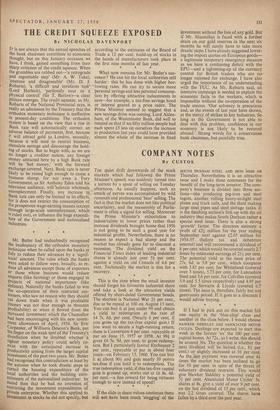COMPANY NOTES
By CUSTOS THE quiet drift downwards of the stock markets which had followed the Prime Minister's speech was suddenly turned into a torrent by a spate of selling on Tuesday afternoon. As usually happens, such an • attack of nerves was accomplished by wild rumours and professional 'bear' selling. The fact is that the market does not like political uncertainty, and the reassembly of Parlia- ment is often a signal for selling. Moreover the Prime Minister's exhortation to industrialists to lower prices rather than increase dividends brought home that 1956 is not going to be such a good year for industrial profits. Nevertheless, there is no reason to expect a bad slump and the market has already gone far to discount a recession. The dividend yield on the Financial Times index of leading industrial shares is already just over 54 per cent. against a yield on old Consols of 4.6 per cent. Technically the market is due for a recovery.
This is the time when the small investor should forget his favourite industrial share and take a look at the attractive yields offered by short-dated Government bonds. The shortest is National War 24 per cent., due to be repaid at 100 on August 15 next. You can buy it at just under 99 and obtain a yield to redemption at the rate of £4 7s. 6d. per cent. (Nearly 6 per cent. if you gross up the tax-free capital gain.) If you want to secure a high-running return, there is Conversion 4 per cent. repayable at par on June 15, 1957 or 1958. At 994 it gives £4 5s. 9d. per cent, to gross redemp- tion. But I particularly favour Exchequer 2 per cent., repayable at par in about four years—on February 15, 1960. You can buy it at about 90} and gain nearly 10 points tax-free if you hold it to redemption. The true redemption yield, if this tax-free capital gain is grossed up, works out at £6 8s. 4d. per cent.—a fine reward for being virtuous enough to save instead of spend ( If the slide in share values continues there will not have been much 'stagging' of the
SOUTH DURHAM STEEL AND IRON issue on Thursday. Nevertheless it is an attractive issue and I make these comments for the benefit of the long-term investor. The com- pany's business is divided into three sec- tions—one producing pig-iron and steel ingots, another rolling heavy-to-light steel plates and track rails, and the third making large steel pipes and steel storage tanks. It is the finishing section's link-up with the oil industry that makes South Durham rather a special steel issue. There is also a strong `growth' factor. The directors estimate a profit of £24 million for the year ending September next against £2.05 million for 1954-55 (before tax and debenture interest) and will recommend a dividend of 8 per cent. which would be covered nearly 2.7 times by estimated earnings of 214 per cent. The potential yield at the issue price of 27s. 6d. is 5.8 per cent., which compares with 5.85 per cent. for Whitehead (covered over 3 times), 5.75 per cent. for Lancashire Steel and 5.6 per cent. for Colvilles (covered 5.9 and 5.5 times respectively) and 4.95 per cent. for Stewarts & Lloyds (covered 6.7 times). The issue is, therefore, fairly but not generously priced. If it goes to a discount I would advise buying.
If I had to pick out on this market fall one equity in the 'blue-chip' class and another in the class below, I would choose HAWKER SIDDELEY and ASSOCIATED MOTOR CYCLES. Dealings are expected to start this week in the former 'ex' the 100 per cent. capital bonus. At 72s., as I write, this should be around 36s. The question is whether the next dividend will be halved (i.e., 84 per cent.) or slightly increased at 10 per cent. As the last payment was covered over 44 times the market has been inclined to go for 10 per cent. in spite of the threat of voluntary dividend restraint. This would give Hawker Siddeley a potential yield of 54 per cent. Associated Motor Cycles' 5s. shares at 8s. give a yield of over 9 per cent. on the last dividend of 15 per cent., which was 2.2 times covered. The shares have fallen by a third over the past year.










































 Previous page
Previous page